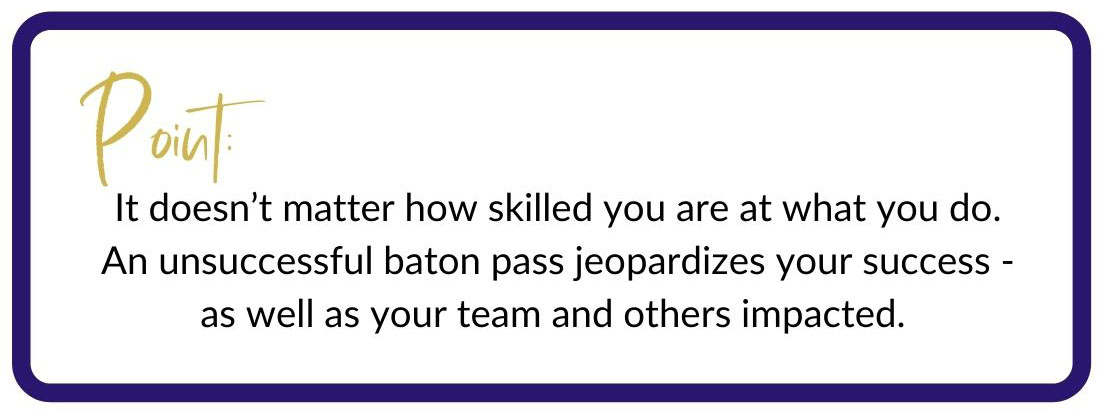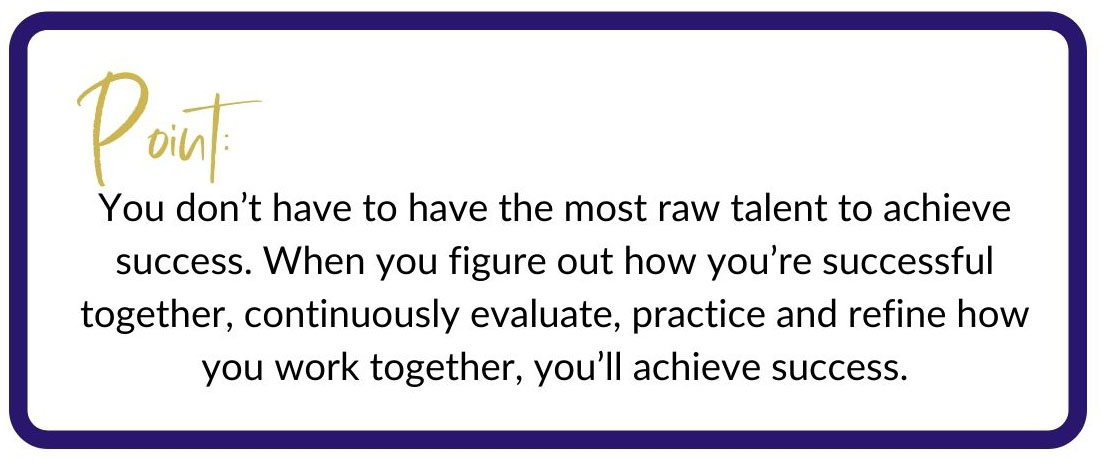If you ask the 2008 United States Olympic Men’s 400-meter relay team why it’s important to successfully pass the baton, they’ll tell you that even the fastest runner in the world can’t help your team win if you don’t get the baton.
In the words of relay race teammate Tyson Gay, following and unsuccessful baton pass that eliminated their chance at Olympic gold:
“I take full blame for it. I feel like I let my teammates down.”


Fellow teammate, Darvis Patton, said he was every bit as much to blame.
“That’s Tyson Gay,” he said. “He’s a humble guy, but I know it’s my job to get the guy the baton and I didn’t do that.”
The team had prepared for years for this race and, in one bad baton pass, everyone on the team – and those who supported them – felt frustration and defeat.
Following the race, the chief executive officer of USA Track & Field, Doug Logan, promised “a comprehensive review” of all of the team’s programs. “Included in this assessment,” he said, “will be the way we select, train and coach our relays.”

If you ask the 2016 Japanese Olympic Men’s 4x100m relay team why it’s important to successfully pass the baton, they’ll tell you that executing the best baton pass makes up valuable seconds and positions them to medal in a race no one thought they could.
None of the Japanese teammates had run a 100m in under the 10 seconds. Other competing teams had individuals who did run the 100m in under 10 seconds.
On paper, there was no way they could medal. They knew the only way they could is if they were more successful executing something they had control over – passing the baton.
After winning the silver medal, Japanese teammate Shota Iizuka was asked about their baton passing strategy:
“We’ve been practicing all the time for about six months, that’s why we’ve done a pretty good job.”


There are times when receive the baton, times when we pass the baton, and times when the baton pass hasn’t been set up. We’ve experienced both the satisfaction of their successes and the frustration of their failures.

Can you relate to any of these?
- You’re part of a team. You’re prepared to complete all your responsibilities accurately and on time. All that’s needed is the information you’re waiting on. It’s delayed, which creates a shorter window for you to successfully complete your responsibilities. In a relay race, the runners must pass the baton successfully in the ‘changeover box’, a specific amount of space where the baton must be passed. If each team member isn’t prepared to pass the baton in the changeover box, it doesn’t matter how well they perform their responsibilities, the team is disqualified. The additional pressure is placed on you and everyone else on your team – a bad baton pass.
- You’ve researched the steps to follow to complete a task; you’re doing this on your own. You complete each of the steps according to the directions and move on. Sometime later you’re contacted asking when you’ll have your information completed. You learn the step that transfers your information to where it needs to go hasn’t been set up – no baton pass.
- You and your teammates don’t naturally communicate in the same style. You meet together and acknowledge this. You agree on a common communication style for the project. You frequently check in with each other to make sure each person is confident in the communications. Everyone stays in sync with each other and there’s no frustration or confusion – a good baton pass.
Whether it’s successfully navigating transitions in our lives or our responsibilities as part of a team, community, or family, it’s important to recognize what’s needed for everyone involved in the success of the ‘baton pass’.
Here are 5 steps for you – and other participants when you are working with a team – to pass the baton successfully.

Step 1: Create a clear vision of specifically what you want and how it impacts you.
- What specifically do you want?
- For what purpose do you want it?
- What will you gain or lose if you achieve it?
- What will you gain or lose if you don’t achieve it?
- How will you feel when you’re successful?
- How will you feel if you’re unsuccessful?
- How will this impact you in each area of your life?

Step 2: Clarify what’s involved for your successful outcome.
- What resources are required for your success?
- Who else must be involved?
- Is there anything holding you back from achieving success?
- What is the timeframe?
- Ask yourself the question successful entrepreneur Gary W. Keller asks: “What is the ONE thing you can do such that by doing it everything else will be easier or unnecessary?”

Step 3: Accept where you are and stay present to see possibilities.
- Accept 100% responsibility for exactly where you are right now without judgement. You don’t have to like it, agree with it, or understand it.
- Without bringing in the past or fortune telling the future, stay fully present in the moment.
- How do you feel about what you want?
- Is there any resistance in you about what you want?
- Do you have any concerns about anyone else on your team?
- Do you feel confident this is really what you want?

Step 4: Understand and align what’s important to you with what you want.
- Do you have a purpose statement for your life? If so, is what you want aligned with it?
- What is most important to you – your values?
- What do you believe to be true – your beliefs?
- Is what you want aligned with these?

Step 5: Identify the actions necessary to successfully pass the baton.
- Write down how you’ll know you’ve achieved success.
- Identify 5 – 10 things you would have had to have done to achieve what you want.
- Begin with one of the things on your list and keep going through your list, continuously checking in to make sure you’re still aligned with your vision of success.
When we implement these 5 steps:
- We’re able to recognize a potential bad baton pass, take wise action, and make it successful.
- We feel satisfied and celebrate the successful baton pass knowing nothing’s missing.
- When a baton pass is missing, we’re able to work with acceptance and presence and without judgement, determine what’s needed, and take wise action to achieve what we know we want.
If you’re curious about what else is possible, let’s start a conversation.





0 Comments